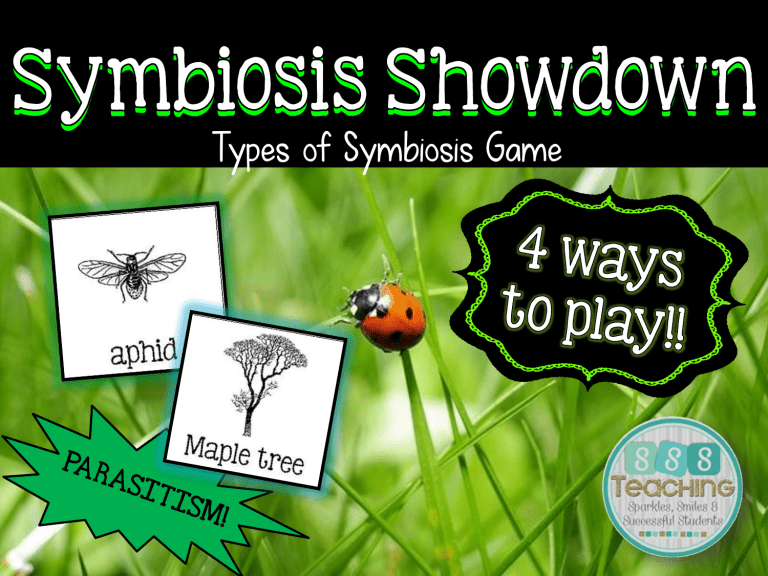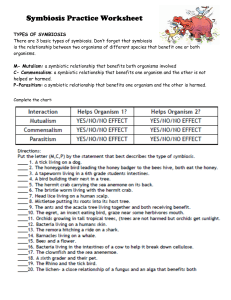
Types of Symbiosis Game •Directions for different ways to play •14 matching pairs of symbiotic organisms •List of the pairs and types •Worksheet to use to extend activity •Could be given as homework •Could be required to include different types of symbiosis Ways to play: 1. Play as a game! 2. Use as a sort 3. Group work 4. Research 1. Print out all cards and headers. Have groups or one student sort the pairs under each type of symbiosis. *use the iPad to take pictures as an assessment. 2. Without giving pairs away give groups all of the animals and have them pair them up and why they work. *use technology to do research* 3. Print out cards and read students out the pairs (just the description part) and they build a sort and poster at their seats based on the types of symbiosis. Pass out all the cards to student around the room. Call out an animal pair. For example, “Cow and cattle egret” The students with those 2 cards come to the front of the room for a showdown. Read the description “the cattle egret gets bugs from the back of the cow and it is neither harmed or bothered.” the students decide what type of symbiosis it is (we have the headers attached to the board) and they place it in the correct location. I love this version because it involved all students and it goes quickly but you can play the other versions to review the different types. cow Cattle egret aphid Maple tree Barnacle whale Mosquito Human Human dog Shrimp Goby fish Acadia tree ant Rhinoceros Oxpecker Cuckoo bird warbler Mistletoe Spruce tree deer Burdock plant Crocodile Egyptian Plover Clownfish Sea anemone Commensalism Parasitism Flea mouse List of combinations and types of symbiosis Animal pairs Types of symbiosis Cow and cattle egret Commensalism – cattle egret gets food (bugs) and the cow is neither harmed nor hurt Aphid and maple tree Parasitism – aphid eats sap from trees. Trees need the sap to help them survive. Barnacle and whale Commensalism – barnacle gets transportation and whale is not harmed Mosquito and human Parasitism – human has scratching or pain and mosquito gets blood. Human and dog Mutualism- dogs provide protection and company and humans provide shelter and food. Goby fish and shrimp Mutualism- shrimp digs hole, both animals live in. Because shrimp is nearly blind the fish will touch the shrimp when predator is nearby. Acadia tree and ant Mutualism- ant burrows in the thorn to have shelter. It protects the tree from any small predators. Oxpecker and rhinoceros Mutualism – oxpecker gets a free meal when it eats the ticks that drink the rhinoceros blood. Cuckoo bird and warbler Parasitism – Cuckoo bird will lays its own eggs in the warbler nest for them to take care of. Mistletoe and spruce tree Parasitism – the mistletoe takes water from the tree as it grows up the branches. List of combinations and types of symbiosis Animal pairs Types of symbiosis Deer and Burdock plant Commensalism – deer moves around through forest and takes the burrs from the plant that need to be transported. Crocodile and Egyptian Plover Mutualism – eats the leeches out of the crocodile’s mouth. Clownfish and sea anemone Mutualism- clownfish is protected and given shelter. Sea anemone gets algae eaten that could harm it. Flea and mouse Parasitism- the flea attaches to mouse and drinks its blood. Name: ________________ Symbiosis Showdown Place cards or draw animals to represent symbiotic relationships. Explain on the lines below how it fits that type of symbiosis. Type of Symbiosis: _________________ ______________________________ ______________________________ ______________________________ ______________________________ Type of Symbiosis: _________________ ______________________________ ______________________________ ______________________________ ______________________________ •This is for ONE classroom use only! It may not be uploaded in any form to the Internet. Please direct others to my store for additional licenses: http://teacherspayteachers.com/sssteaching •Please direct any questions to newteacherniche@gmail.com •You can follow my blog for more great science ideas: http://sssteaching.blogspot.com Clipart: clker.com



